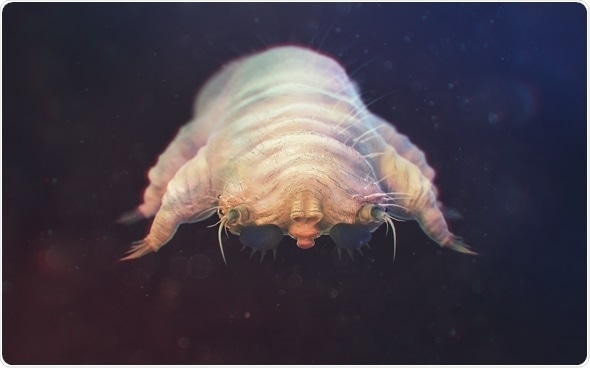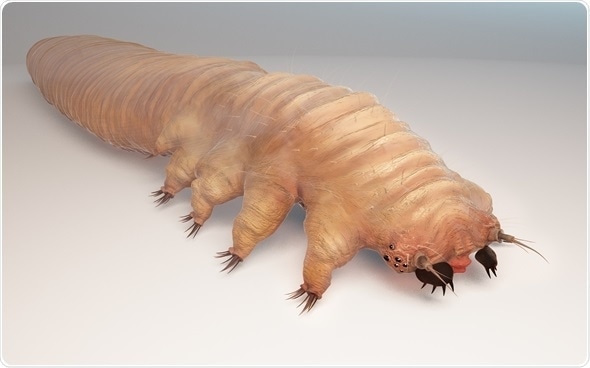New Approaches for Fighting Demodex Mites
 By Keynote ContributorBy Dr. Kathryn Najafi-Tagol, MDFounder and Medical Director of the Eye Institute of Marin
By Keynote ContributorBy Dr. Kathryn Najafi-Tagol, MDFounder and Medical Director of the Eye Institute of MarinBy Dr. Kathryn Najafi-Tagol, MD, Founder and Medical Director of the Eye Institute of Marin
Demodex mites are one of the most challenging problems that ophthalmologists and optometrists face in the routine care of their patients.

© Kalcutta / Shutterstock.com
These mites are microscopic parasites that live on eyelids and other parts of the face. One of the two species, Demodex folliculorum, buries itself face down near the roots of eyelashes. It uses a seven-clawed organ (a “palpus”) to grab hold of cells. Then it feasts on the cells that line the follicle, sucking out their innards with a retractable needle in the middle of a round mouth.
The waste material the mites produce builds up as debris on the eyelids and causes inflammation.
In addition, the D. folliculorum typically carries Staphylococcus and Bacillus oleronius bacteria.

© Kalcutta / Shutterstock.com
The combination of mites and bacteria causes blepharitis, a condition suffered by more than 20 million Americans, where the eyes become red, irritated and painful, and crusty debris builds up on the eyes.
Meanwhile, the other species, Demodex brevis, burrows into meibomian gland to feed, often plugging up this crucial gland. The gland produces an oily substance that’s necessary to keep tears from evaporating. As a result, the D. brevis mites are associated with meibomian gland disease, also known as dry eye.
These parasites are common. One study found them in 25% of 20-year-olds, 30% of 50-year-olds and 100% in patients older than 90 years old.
My own patients are usually horrified when I tell them that there are tiny parasites, which are relatives of ticks, spiders, and scorpions, feasting on cells around their eyes.
So how can we fight these parasites? There are several approaches, which can be combined to attack the mites on multiple fronts:
Tea Tree Oil
At high concentrations, tea tree oil is a potent killer of Demodex mites. The problem is that solutions of 100% tea oil, or other high concentrations, are very irritating to the eye. So one approach is to thoroughly wipe the eyelashes and eyebrows with a diluted solution of tea tree oil, from 5% to 50%. We can also first use an anesthetic eyedrop to lessen the irritation from the tea tree oil.
In one study, a daily lid wipe with a 5% solution of tea tree oil reduced both the numbers of mites and the perceived itchiness of the eyes.3 Until recently, tea tree oil was the main method of keeping the mites in check.
Antibiotics & Steroids
An antibiotic steroid ointment can help prevent the mites from moving. It may even suffocate them. The combination of antibiotics and steroids is also a standard treatment for blepharitis. The steroid reduces inflammation, which is caused by the mites, the bacteria, and treatments like tea tree oil wipes. In addition, the antibiotic helps control the bacteria.
The problem with this approach is that steroids can worsen glaucoma, while chronic use of antibiotics can lead to the development of bacteria that are resistant to the antibiotics.
Hypochlorous Acid
Hypochlorous acid (HOCl) is a naturally occurring substance produced by white blood cells as a first defense against microbial invaders. Its antimicrobial properties were recognized more than 100 years ago, when solutions containing HOCl were used to combat infections in the wounds of soldiers injured in WWI.
Only recently, however, has it been possible to manufacture a stable, pure version of HOCl. HOCl has potent antimicrobial properties. Laboratory studies show that it effectively kills the nymph form of the Demodex mites, as well as the Bacillus oleronius and Staphylococcus aureus bacteria that live on eyelids and that are found inside the Demodex gut. In addition, HOCl also neutralizes the inflammatory toxins released by both mites and bacteria.
Moreover, unlike tea tree oil, HOCl is completely non-toxic and non-irritating.

© Nyrelle Hawkins / Shutterstock.com
Home Hygiene
Treating eyes and eyelids can bring quick relief to patients, many of whom have suffered from Demodex mites, blepharitis, or dry eye for years.
But there are also steps patients can take at home to further reduce the problem. I recommend washing sheets and pillowcases in hot water and drying with the hottest possible dryer setting to kill the mites that might otherwise jump from bedding to faces. In some cases, it might even help to get new pillows. Patients might also consider not using makeup for a week, and discarding their old makeup.
Many doctors worry that patients won’t comply with the treatments they recommend. But I find that once I describe to patients how parasites are burrowing into their cells and feasting on their bodies, especially if I show them pictures of the microscopic creatures, I get their attention and their complete cooperation. In addition, if the treatment is irritating like tea tree oil products, the patients are less likely to be compliant; however, if the therapy feels comfortable and makes the eyelids feel more refreshed, the patients are more likely to adhere to the regime.
And the good news is that, after years of fighting mites and treating chronic blepharitis, new approaches are making it more likely that we can finally effectively control these conditions.
Sources
- blogs.discovermagazine.com/…/#.Vso1oTZWihV
- http://www.onjoph.com/english/demodex.html
Further Reading
- All Mites Content
Disclaimer: This article has not been subjected to peer review and is presented as the personal views of a qualified expert in the subject in accordance with the general terms and condition of use of the News-Medical.Net website.
Last Updated: Jun 25, 2019
Source: Read Full Article
